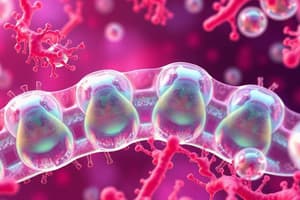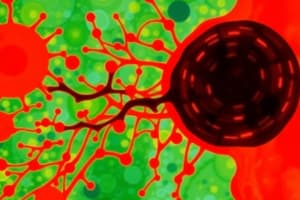Podcast
Questions and Answers
What is one significant role of microbes in the environment?
What is one significant role of microbes in the environment?
- Carbon fixation
- Gas exchange
- Photosynthesis
- Pollutant remediation (correct)
Which process involves the transfer of genetic material between organisms without reproduction?
Which process involves the transfer of genetic material between organisms without reproduction?
- Conjugation (correct)
- Meiosis
- Mitosis
- Binary fission
What is the first step in the process of protein synthesis?
What is the first step in the process of protein synthesis?
- Decarboxylation
- Translation
- Transcription (correct)
- Replication
How do genetic variations support the adaptability of microbial populations?
How do genetic variations support the adaptability of microbial populations?
Which of the following mechanisms does NOT contribute to genetic diversity in microbes?
Which of the following mechanisms does NOT contribute to genetic diversity in microbes?
Which cellular characteristic is unique to eukaryotic cells compared to prokaryotic cells?
Which cellular characteristic is unique to eukaryotic cells compared to prokaryotic cells?
What is the primary function of ribosomes within a cell?
What is the primary function of ribosomes within a cell?
Which process in microbial metabolism involves the synthesis of complex organic molecules?
Which process in microbial metabolism involves the synthesis of complex organic molecules?
Which of the following best describes catabolism?
Which of the following best describes catabolism?
What role do microorganisms play in biogeochemical cycles?
What role do microorganisms play in biogeochemical cycles?
Which structural component is not universally found in all microorganisms?
Which structural component is not universally found in all microorganisms?
How do microorganisms exhibit metabolic diversity?
How do microorganisms exhibit metabolic diversity?
What is a significant factor affecting microbial activities in ecosystems?
What is a significant factor affecting microbial activities in ecosystems?
Flashcards
Prokaryotic Cell
Prokaryotic Cell
A type of cell that lacks a nucleus and membrane-bound organelles. Found in bacteria and archaea.
Eukaryotic Cell
Eukaryotic Cell
A cell with a nucleus and membrane-bound organelles. Found in fungi, protists, and plants.
Microbial Metabolism
Microbial Metabolism
All biochemical reactions inside a microorganism. Includes breaking down (catabolism) and building up (anabolism) molecules.
Catabolism
Catabolism
Signup and view all the flashcards
Anabolism
Anabolism
Signup and view all the flashcards
Environmental Microbiology
Environmental Microbiology
Signup and view all the flashcards
Microbial role in ecosystem
Microbial role in ecosystem
Signup and view all the flashcards
Cell Wall
Cell Wall
Signup and view all the flashcards
Microbial Genetics
Microbial Genetics
Signup and view all the flashcards
DNA Replication
DNA Replication
Signup and view all the flashcards
Horizontal Gene Transfer
Horizontal Gene Transfer
Signup and view all the flashcards
Bioremediation
Bioremediation
Signup and view all the flashcards
Genetic Variation (in microbes)
Genetic Variation (in microbes)
Signup and view all the flashcards
Study Notes
Fundamentals of Microbiology
- Microbiology is the study of microorganisms, including bacteria, archaea, fungi, protists, and viruses.
- Microorganisms are ubiquitous, existing in diverse environments, from soil and water to the human body.
- Microbiology plays a crucial role in various fields, including medicine, agriculture, and industry.
- The study of microbiology involves observing, identifying, and classifying microorganisms.
- Tools used in microbiology include microscopes, various staining techniques, and culture media.
- Microorganisms exhibit remarkable diversity in their structure, metabolism, and genetics.
- Understanding microbial activities is vital for comprehending ecosystem functions and human health.
Cell Structure
- Prokaryotic Cells (Bacteria and Archaea):
- Lack a nucleus and membrane-bound organelles.
- Have a cell wall, plasma membrane, cytoplasm, and ribosomes.
- Some have flagella (for movement) and pili (for attachment).
- DNA is concentrated in a nucleoid region.
- Eukaryotic Cells (Fungi, Protists, and Algae):
- Possess a nucleus and membrane-bound organelles.
- Have a more complex internal organization.
- DNA is contained within the nucleus.
- Often larger relative to prokaryotic cells.
- Common Cell Structures:
- Cell wall provides structural support and protection (not in all cells).
- Plasma membrane regulates the passage of materials into and out of the cell.
- Cytoplasm is the jelly-like substance filling the cell.
- Ribosomes synthesize proteins.
Microbial Metabolism
- Metabolism encompasses all biochemical processes within a cell.
- Catabolism: Breakdown of complex organic molecules to release energy (e.g., respiration, fermentation).
- Anabolism: Synthesis of complex organic molecules from simpler ones, requiring energy (e.g., biosynthesis).
- Energy Sources: Organisms can be categorized based on their energy source (light or chemicals).
- Carbon Sources: Organisms can use different carbon sources (CO2, organic molecules).
- Metabolic diversity: Microorganisms exhibit vast metabolic diversity, enabling them to thrive in diverse environments. Factors include oxygen requirements, nutrient preferences.
Environmental Microbiology
- Environmental microbiology focuses on microorganisms in their natural environments.
- Microorganisms play crucial roles in biogeochemical cycles (e.g., carbon, nitrogen, sulfur cycles).
- They influence nutrient cycling, decomposition, and soil fertility.
- Their role in remediation of pollutants is significant and researched.
- Microbes can be used in bioremediation, a process that utilizes microbes to break down pollutants.
- Microorganisms affect the sustainability of ecosystems.
Microbial Genetics
- Microbial genetics examines the structure, function, and evolution of microbial genes.
- Genes are segments of DNA that carry genetic information.
- DNA replication: DNA is copied to ensure genetic continuity.
- Transcription: DNA is transcribed into RNA.
- Translation: RNA is translated into proteins.
- Genetic variations: Microbes can evolve and gain new traits by mutations and genetic exchange.
- Horizontal gene transfer: genetic material can be transferred between organisms in ways that do not involve reproduction, including transformation, conjugation, and transduction. These mechanisms help maintain the adaptability of microbial populations in changing environments. Mechanisms allow speed of adaptation.
- Microbial genetics is critical to understanding the adaptation and survival of microorganisms in different environments.
- Understanding microbial genetics is essential in combating resistant strains, monitoring epidemics, and developing new strategies for applications like bioremediation.
Studying That Suits You
Use AI to generate personalized quizzes and flashcards to suit your learning preferences.
Description
This quiz covers the key concepts of microbiology, focusing on microorganisms, their environments, and cell structures. Understand the differences between prokaryotic cells and their features, as well as the various tools and techniques used in microbiological studies. The importance of microbes in medicine, agriculture, and industry will also be highlighted.




